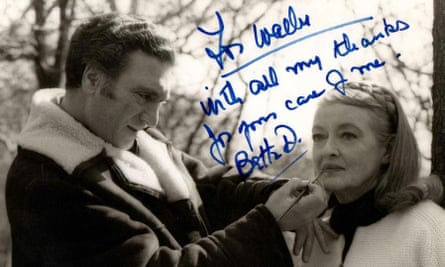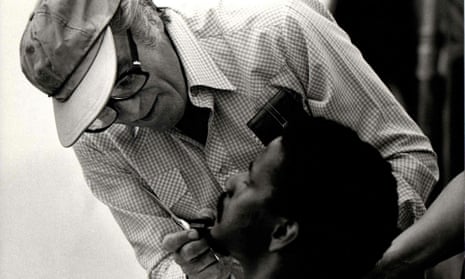The complex makeup required for the title character of The Elephant Man was nearly the undoing of that celebrated 1980 film. Its director, David Lynch, had the first stab at designing workable prosthetics. “But when I tried a piece of it on John Hurt,” Lynch recalled, “he couldn’t move and he said, ‘A valiant effort, David’.” Lynch was plunged into despair, certain that his film would be a disaster, until the British makeup artist Christopher Tucker came to the rescue. But applying the resulting designs, which had been modelled from a cast of the real Joseph Merrick, whose story the movie told, fell upon the makeup artist Walter Schneiderman.
Schneiderman, who has died aged 98, called the film “one of the hardest pictures I had to do”. It took seven hours each day to put the makeup on Hurt, and another two to take it off again. “Everything was so precise,” he said. “There were 14 pieces, not including the head, and they had to be applied exactly, every day for continuity. You couldn’t afford to make a mistake.” Schneiderman was acclaimed for his work on the movie, which was nominated for eight Oscars. The lack of official recognition for Tucker and Schneiderman caused a furore, which led to the implementation the following year of a new Oscar category for best makeup.
Known to his friends as Wally, Schneiderman was born in London to Chaim Baruch and Boobie Rose, who were tailors. His father died when Wally was 10. Four years later, Wally left the Kensington Bayswater Jewish school (later the Solomon Woolfson school) and began working as an apprentice hairdresser. At 18, he joined the RAF and served as a gunner during the second world war.
After being demobbed, he enrolled at the Academy of Gentlemen’s Hairdressing in London. When the head makeup supervisor at Shepperton film studios called in looking for barbers willing to train as makeup artists, Schneiderman volunteered. His first visit to a film set was in 1947, when he watched Alexander Korda directing An Ideal Husband, an adaptation of the Oscar Wilde play.

Uncredited early work came his way on Anna Karenina (1948), starring Vivien Leigh, and Powell and Pressburger’s Tales of Hoffman (1951). However, as the industry offered only short contracts and meagre pay, when business was scarce Schneiderman would return to hairdressing to make ends meet.
From the mid-1950s, though, he started to get more stable work. He spent five years, first as makeup artist and then as makeup supervisor, on the television series The Adventures of Robin Hood (1955-60). He moved into more film work with The Guns of Navarone (1961), I Could Go On Singing (1963), with Judy Garland and Dirk Bogarde, One Million Years BC (1966) and The Dirty Dozen (1967). Isadora (1968) was the first of several movies he made with Vanessa Redgrave, one of many actors who began to stipulate him as their preferred makeup artist.
After Fiddler on the Roof (1971), he acquired an agent and landed work on blockbusters such as Juggernaut (1974) and Rollerball (1975). For the TV film A Woman Called Golda (1982), he helped to turn Ingrid Bergman and Judy Davis into the older and younger Golda Meir respectively, cleverly creating continuity between the two performers. An extended period working for Barbra Streisand on her period musical Yentl (1983) prevented him from accepting an offer from Robert De Niro, who personally met him to request his services for the vital ageing makeup that would be required in Sergio Leone’s Once Upon a Time in America (1984).

Schneiderman was makeup supervisor on the fantasy Labyrinth (1986), starring David Bowie as the flamboyant Goblin King. His final assignments included two films directed by Richard Attenborough: the apartheid drama Cry Freedom (1987), starring Denzel Washington as the anti-apartheid activist Steve Biko, and Chaplin (1992), in which Schneiderman oversaw the process of ageing Robert Downey Jr, then 26, from 19 years to 83 in the title role.
Although an inventive and resourceful practitioner, he was always practical. “Directors think you open your box and out pops magic,” he said. “It does. But you’ve got to know how to apply it.” After his retirement, he went on to create and sell a line of commercial products under the name Make-Up International. Among them were Quick Action Powder Blood, Bruise Simulation Gel and Omaha Action Mud.
His wife, Ruby, whom he married in 1943, died in 2001. He is survived by their daughters, Beryl and Karen.

Comments (…)
Sign in or create your Guardian account to join the discussion